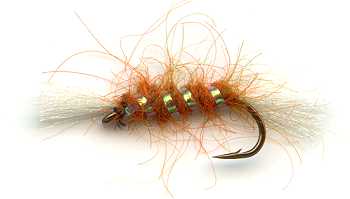Rusty Orange Shipman's Buzzer Midge Emerger Nymph
Dave Shipman designed his classic Shipman's Buzzers fishing fly to imitate Tiny Chironomid stuck in the water surface film as they were struggling to emerge.

SHIPMAN'S BUZZER (CHIRONOMIDS) MIDGE EMERGER NYMPHS FLY PATTERNS. Hook size 10 12 14 - $US each
The scruffy fibers sticking out of the Rusty Orange Shipman's Buzzer Midge dry fly pattern helps the fly stay on the surface and fool the trout to thinking that it is part of the body and legs of a real floating insect. When you see fish taking food from the top of the water then that is the time to deploy a Shipman's buzzer. The white fibers at the front and rear of the fly help with buoyancy and increase visibility for the flyfisherman.
So when should you go fishing with a Shipman's Buzzer? Many trout fishermen fit their hobby around their social life. Many go fishing, after breakfast and return home just in time for an evening meal. People had the assumption that the trout is always on the lookout for food. No one's ever seen a trout asleep. He always has his eyes open. From experience I have found that there are definite periods in the day when trout feed more keenly than others. In fact, at certain times, they seem to be totally uninterested in feeding. If you keep casting over a fish that is not interested in feeding you run the risk of disturbing them and thus ruining your chances later when they are hungry.
Most fly hatches develop with the approach of evening. More and more trout begin to feed just under the surface on rising insects and then later on the surface as the adult flies begin to emerge. I find it so strange to see flyfisherman packing their bags, walking to their cars, driving home at this important time. It's crazy. They are missing the best of the day's flyfishing.
One of the other most productive times for flyfishing is just before dawn. If you want to have a great days sport, you have to set your alarm very early. Many anglers start fishing after they have enjoyed a good breakfast. They are greeted by the sight of a flat water surface on the lake or reservoir when they arrive. There is not a fish to be seen breaking the the surface, causing ripples. When they greet me with a friendly "good morning", I have to tell them that they should have come at dawn when the surface was "boiling" with activity.
There are many other things that affect when the trout will take your fly. When you are fishing on the River that is in spate after a good thunderstorm, many trout move downstream, after they have spawned, to deeper less turbulent water. It is not a good idea in these circumstances spend your whole day trying to catch a fish in the headwaters of a river. Again, there is not a big chance of catching a fish in the river's headwaters in spring before the return of the annual migration.
Trout will normally rise to munch on flies that are hatching or falling on the water surface. They look from nymphs and pupae that are swimming up to the water surface just prior to the Hatch. They eagerly look for the shadow movement on the surface indicates hatching adult may fly just waiting for its wings to dry before flying off. These are easy prey. Trout also hunt female mayflies laying eggs by dipping their tail in the water surface or swimming underwater to lay them near vegetation. Spent, exhausted adult mayflies fall to the surface and drown. This is easy food for predatory trout. On windy days trout are on the lookout for windblown land insects like grasshoppers, daddy longlegs, ants, and beetles floating on the surface, struggling to get dryland. You should plan your fishing trip around nature and not your normal eating habits. Get up early and go home late. If you want, have a snooze in the afternoon sun.
Fly Fishing books

